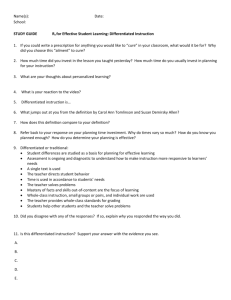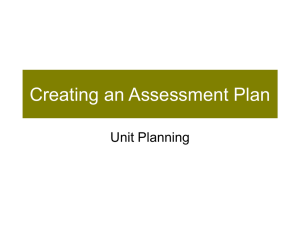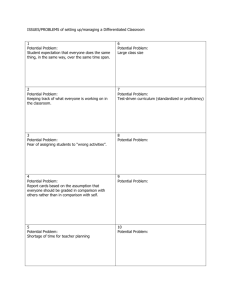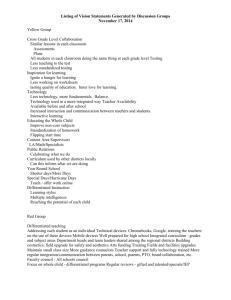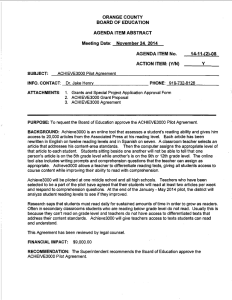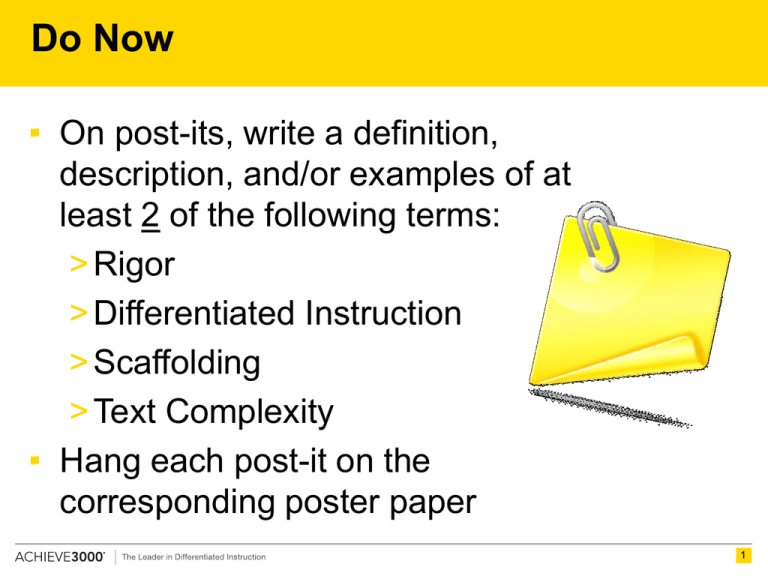
Do Now
On post-its, write a definition,
description, and/or examples of at
least 2 of the following terms:
> Rigor
> Differentiated Instruction
> Scaffolding
> Text Complexity
Hang each post-it on the
corresponding poster paper
1
The Path to Career and
College Readiness:
Revisiting why we pursue, what we know
about, and how we support
differentiated instruction
Heidi A. Ramirez, PhD
Chicago Literacy Leadership Conference ,
July 30, 2014
Confidential and Proprietary
© 2012 Achieve3000 and its licensors. All rights reserved.
Session Goals
• Clarify key terms and strategies guiding efforts to
improve college and career readiness
• Do you and your staff have shared language and
expectations—across programs, departments,
etc.?
• Where do you have consensus and where do you
need it?
• Reflect on differentiated instruction in practice—
unpacking myths and manipulations in pursuit of
effective instruction
• Are you clear about the challenges?
• Consider the coherence question—how can you
better frame, communicate, and support
differentiated instruction in the larger reform context
3
US Students Perform
Well Internationally
TIMMS/PIRLS
(4th grade, 2011 test)
Reading: Statistically
significantly out-scored
by only 4 countries (and
gained 14 points since
2001)
Math: Performed near
middle of second-tier
countries (w/ 23-point
gain since 1995)
Science: Statistically
significantly out-scored
by 6 countries
… and US students continue to make progress
5
… though performance varies by state
6
… and progress has been elusive in Illinois
No significant difference:
between percent at/above
proficient on NAEP in 2013
(34%) and in 2011 (33%) or 2003
(31%)-- of IL 4th graders; no
significant change at Basic
in average IL 4th grade score
between 2011 (219) or 2003
(216)
In 2013, average IL NAEP score was:
-lower than in 29 states/jurisdictions
-higher than in 11
-not significantly different from 11
on score gaps between high- and
low- performing, black and
white, or high- and low-poverty
students, 2011-2013
7
Illinois ACT Scores also show little progress in
improving Career and College Readiness
8
US Schools serve more diverse students,
especially in urban districts
TUDA districts by percent 4thTUDA districts by percent white
grade FRPL-eligible students (2013) 4th-grade students (2013)
http://nationsreportcard.gov/reading_math_tuda_2013/#/tuda-the-same
Significant gaps persist for urban districts
About 30% of
K-12
population in
the US
(~15 million
students)
attends
schools in
urban districts
Trend in average public school 4thgrader on NAEP reading
http://nationsreportcard.gov/reading_math_tuda_2013/#/large-cities
… Even though urban districts are
improving faster than others
While public
school students
in large cities are
consistently outperformed by
their non-urban
counterparts on
NAEP, students
in TUDA districts
are making
greater gains.
Change in average scores for 4th and 8thgrade public school students on NAEP
mathematics and reading (2002, 2003, and 2013)
http://nationsreportcard.gov/reading_math_tuda_2013/#/large-cities
… And Chicago’s growth is out-pacing
the Nation
1
2
… But Career and College Readiness
requires even more, faster
1
3
… and calls for an updated instructional
pathway to Career and College Readiness
• Instructional goals
• Knowledge of content
and pedagogy
• Knowledge of students
• Knowledge of resources
• Coherent instruction
• Assessment of student
learning
Planning &
Classroom
Preparation
Environment
Professional
Responsibilities
Instruction
• Environment of Respect
and Rapport
• Culture of Learning
• Classroom Procedures
• Student Behavior
• Management
• Organization of
Physical Space
RIGOR
• Reflection on Teaching
• Accurate Records
• Communication with
families
• Contributions to the
school and district
• Professional growth
• Professionalism
• Clear and accurate
communication
• Questioning and
discussion techniques
• Student engagement
• Feedback to students
• Flexibility and
responsiveness
Framework for Teaching (Danielson, 1996, 2007)
14
Illinois Model for
Teacher Evaluation and Support
Academic Rigor:
What do we mean
and
how do we measure it?
Confidential and Proprietary
© 2012 Achieve3000 and its licensors. All rights reserved.
16
Rigor: What is it?
“encourage[s] students to think critically, creatively, and
more flexibly… learning environments that are …
stimulating, engaging, and supportive… help students
understand knowledge and concepts that are complex,
ambiguous, or contentious, and to acquire skills that
they can apply… throughout their lives”
“academic relevance and critical-thinking skills such as
interpreting and analyzing… making connections
referring to learning standards and high expectations
standards, … educational equity” (http://edglossary.org/rigor/)
1
7
Rigor: Samples from CCSS
1
8
Rigor
1.
2.
3.
4.
5.
6.
7.
Critical Thinking and Problem Solving
Collaboration and Leadership
Agility and Adaptability
Initiative and Entrepreneurialism
Effective Oral and Written Communication
Accessing and Analyzing Information
Curiosity and Imagination
(Wagner, “Rigor Redefined” in Educational Leadership,
October 2008, Volume 66, Number 2:20-25)
1
9
Rigor through CCSS Shifts in ELA/Literacy
Building knowledge through content-rich, non-fiction
and informational texts [Reading Standards #1-10 in
ELA and Reading Standards for History/SS,
Science, and Technology]
Reading, writing, and speaking grounded in
evidence from the text [Reading Standard #1,
Speaking and Listening Standard #1, and Writing
Standards #1, #2, #9]
Regular practice with complex texts
and their academic vocabulary [Reading Standards
#10 and #4]
Higher Standards:
CCSS English Language Arts
“The goal for readers of all ages is to be able to
understand and learn from what they read and to
express such knowledge clearly through
speaking
andawriting
about text.”
“Read
like
detective
and write like
an investigative reporter”
– David
CCSS
author
“The Coleman,
standards
focus
intently on students
reading closely to draw evidence from the text
and are emphatic about students reading texts
of adequate range and complexity.”
(Publishers’ Criteria for the Common Core State Standards in
English Language Arts and Literacy, Grades 3-12, CCSSO )
Career and College Readiness calls for
More Informational Text
Percentage distribution of literary and informational
passages:
Grade
Literary
Informational
4
50%
50%
8
45%
55%
12
30%
70%
Informational text is key!
Source: National Assessment Governing Board. Reading Framework for the 2009 National Assessment of Educational Progress.
Washington, D.C.: American Institutes for Research, 2009.
22
Career and College Readiness calls
for Increased Text Complexity
2
3
Text Complexity
• The variables that affect “text complexity” the most
are:
Structure
Purpose
Style and language
Richness
Relationships
Knowledge demand
2
4
Text Complexity
1. Qualitative measures- levels
of meaning, structure,
language conventionality
and clarity, and knowledge
demands
2. Quantitative measures- word
length or frequency,
sentence length, and text
cohesion
3. Reader and task
considerations- motivation,
knowledge, and experiences
“We must open the doors of
opportunity. But we must also equip our
people to walk through those doors.”
--Lyndon B. Johnson
2
8
Differentiated Instruction:
What is it?
Confidential and Proprietary
© 2012 Achieve3000 and its licensors. All rights reserved.
29
Traditional Differentiation
32
Differentiated Instruction
What is it?
“…a process to approach teaching and learning
for students of differing abilities in the same
class. The intent is to maximize each student's
growth and individual success by meeting each
student where he or she is . . . rather than
expecting students to modify themselves for the
curriculum (Hall, 2002 based on researchers National
Center on Accessing the General Curriculum)
3
3
Differentiated Instruction
“A concept that makes it possible to maximize learning
for ALL students. …a collection of instructionally
intelligent strategies based on student-centered, best
practices that make it possible for teachers to
meaningfully respond to the needs of diverse learners. …
made possible by modifying the content, process and/or
product of instruction of a particular student or small
group of students (typically to scaffold and extend
learning), rather than the more typical pattern of teaching
the class as though all individuals in it were basically the
same. Differentiated instruction is an approach to
ensuring all children achieve to the same high standards;
instructional approaches are varied, not the expectations
or the standards” (As drafted, from across the literature, by
Milwaukee Public Schools, 2011)
3
4
Ways to Differentiate Instruction
• Content- What is the standard to which I am
going to teach? What skill am I going to teach?
• Process- How am I going to teach that skill in a
variety of ways that will address the
developmental levels of each of my students?
• Product- What will my students produce as
evidence of understanding of the skill?
3
5
Differentiated, Complex, Informational
Text
Read a sample article (“Remembering the
Past”) from the set.
As you read, consider:
• reading level and text complexity of the
article
Trade sample article with a colleague w/ a
different color.
As you read, consider:
reading level and text complexity of the
article
how the different texts (different colors) are
similar and different
Effective Differentiated Instruction
Focuses on the essential ideas and skills of the content
area, eliminating ancillary tasks and activities
Responds to individual student differences (e.g., learning
style, prior knowledge, interests, level of engagement)
Groups students flexibly by shared interest, topic, or ability
Integrates ongoing and meaningful assessments w/
instruction
Continually assesses, reflects, and adjusts content,
process, and product to meet student needs
> Meaningful, timely, task-specific feedback
(Anderson, 2007; Rock, Gregg, Ellis, & Gable, 2008; Tomlinson, 2000 as cited
in Huebner, 2010)
3
7
Differentiated Instruction
is not:
the same as an intervention
just literacy workstations
only for struggling students
added work
38
Instructional Scaffolding
“What's the opposite of scaffolding a lesson?”
It would be saying to students something like,
‘Read this nine-page science article, write a
detailed essay on the topic it explores, and turn it
in by Wednesday.’ Yikes -- no safety net, no
parachute, no scaffolding -- just left blowing in the
wind” (Alber, Teacher Leadership, “Six Scaffolding Strategies to Use
with Your Students,” May 2011).
3
9
Instructional Scaffolding
specialized instructional supports need to be in place to
facilitate learning
support given during learning process tailored to the
needs of the student to help student achieve his/her goals
“enables a student to solve a problem, carry out a task, or
achieve a goal through a gradual shedding of outside
assistance. …enlists the instructor as an activator… to
facilitate the student’s incremental mastery of a concept”
“a temporary framework for construction in progress”
(Cazden, 1983:6)
4
0
Scaffolding, examples
Resources (e.g., dictionaries, second language
supports, audio-supports, maps)
Pre-teaching key words and/or concepts
Previewing or chunking content
Asking guiding questions
Accessing/building background knowledge
Providing templates, sentence starters, graphic
organizers, note-taking/study guides
Modeling a task, leading a “think-aloud”,
coaching
Helping with goal setting and on-going progress
monitoring
4
1
Differentiation to Promote Discussion
800L
450L
250L
Same topic, differentiated to meet each student, so every student takes part in discussions.
Independent
vocabulary
learning
Embedded
language
supports
Audio
scaffolds
for
struggling
readers
42
Scaffolding Example: Achieve3000 “read as
you go”
*Math Tab Excluded
4
3
Scaffolding Example: Highlighting for
close reading strategies and note-taking
Reach
4
4
Scaffolding Example: Audio support,
“read-as-you-go” audio with highlighting
4
5
Differentiated Instruction: Continuous
Monitoring and Flexible Grouping re: Standards
4
6
Differentiated Instruction: Individual
Learning Pathways (w/ NWEA-MAP)
4
7
Differentiated Instruction: Individual
Learning Pathways (w/ NWEA-MAP)
4
8
Differentiated Instruction: Individual
Learning Pathways (w/ NWEA-MAP)
4
9
Differentiation in
Practice: What really
happens in classrooms?
Confidential and Proprietary
© 2012 Achieve3000 and its licensors. All rights reserved.
While educators understand that not all learners
are the same, and that their needs are diverse, few
teachers accommodate these differences in their
classrooms (Gable, Hendrickson, Tonelson, and Van
Acker, 2000; Guild, 2001)
Uniformity, rather than attending to diversity,
dominates the culture of many contemporary
classrooms (Gable et al., 2000; Guild, 2001; Sizer, 1999)
And failed efforts can sometimes be worse than no
effort to differentiate instruction
5
1
When Myths and Misunderstandings
It’s dangerous when
Prevail: Multiple Intelligences
students are “typecast” as
readers/writers, drawers,
Visual-Spatial - think in terms of physical space, like architects and
actors
anddo
their
access
to
sailors. Very aware of their environments. Like
to draw,
jigsaw
puzzles,
read maps, daydream.
rigor is limited by these
Bodily-kinesthetic - use the body effectively, like
a dancer
a surgeon.
(e.g.,
group or
work
w/
Keen sense of body awareness. Like movement, making things, touching.
assigned roles)
Musical - show sensitivity to rhythm and sound. Like music, but they are
also sensitive to sounds in their environments.
Interpersonal - understanding, interacting with others. Learn through
interaction. They have many friends, empathy for others, street smarts.
Intrapersonal - understanding one's own interests, goals. Tend to shy
away from others, are in tune with their inner feelings; they have wisdom,
intuition and motivation, as well as a strong will, confidence and opinions.
Linguistic - using words effectively. Have highly developed auditory skills
and often think in words. Like reading, playing word games, making up
poetry or stories.
Logical –Mathematical-reasoning, calculating. Think conceptually,
abstractly and are able to see and explore patterns and relationships. Like
to experiment, solve puzzles, ask cosmic questions.
5
2
When Myths and Misunderstandings
Can lead to static
Prevail: Leveled Texts/Readers
student groups,
limited teacher
support, and lack of
access to grade-level
content
Based on theory of Zone of Proximal Development
Research on effectiveness is unclear
Foundation of Calkins’ Reading and Writing
Project/Workshop, “just right” books
“Research shows … matching kids to books does not
guarantee big learning gains…” (Shanahan blog, 2013)
“… If reasonable levels of instructional support are
available then students are likely to thrive when working
w/ harder texts” (Shanahan, 2011,
http://www.shanahanonliteracy.com/2011/08/rejectinginstructional-level-theory.html)
5
3
When Myths and Misunderstandings
Prevail: Activating Prior Knowledge
Readers use prior knowledge to understand
texts. “Having more prior knowledge generally
aids comprehension. There are many aspects to
prior knowledge, including knowledge of the
world, cultural knowledge, subject-matter
knowledge and linguistic knowledge. A reader’s
interest in a subject matter will also influence the
level of prior knowledge. All of these… are
important to different degrees, depending on the
reading task” (Pang, Muaka, Bernhardt and
Kamil, 2003:13).
5
5
Challenges
Can be time consuming and/or distracting
Difficult to predict/access students’ prior
knowledge, especially what is relevant and
accurate (danger of stereotyping)
“Spoon feeding” vs. modeling the strategy of
effective readers/ metacognitive strategy for
students (developing the skill)
5
6
When Myths and Misunderstandings Prevail:
Pre-Teaching Vocabulary (and Concepts)
Vocabulary is developed through both explicit instruction
and implicitly (e.g., incidentally when we read, through
the use of context clues)
One of the most effective methods of explicit vocabulary
instruction is to teach unfamiliar words used in a text
prior to student reading
> The teacher should preview reading materials to
determine which words are unfamiliar.
> These words should be defined and discussed; the
adult should not only tell the child(ren) what the word
means, but also to discuss its meaning---connotations
and denotation
> After pre-teaching vocabulary words, the child(ren)
should read the text
5
7
The stallholder smiled mysteriously. …"Who knows? A
smallest
coin inSomething
wizards’
friend walks by inKnut:
a frog
costume?
currency,
made of bronze
unexpected is bound
to happen…"
Knuts
= 1 silver
Sickle drink can
“…There is, there is29
just
no way
a bloody
Sickles =comedy
1 gold Galleon,
manipulate reality to17
produce
setups, or I'm
going to give up andwhich
retirehas
to the
thegreatest
Bahamas"
value
Draco groaned. "Are we really going to do this?"
"You don't have to drink it but I have to investigate. Have
to. How much?"
"Five Knuts the can," the stallholder said.
"Five Knuts? You can sell reality-manipulating fizzy
drinks for five Knuts the can?" Harry reached into his
pouch, said "four Sickles, four Knuts,” and slapped them
down on the counter. "Two dozen cans please."
"I'll also take one," Draco sighed, and started to reach for
his pockets.
--Harry Potter and the Sorcerer's Stone, Chapter 5
5
8
Gettysburg Address, 1863
“Four score and seven years ago our fathers brought forth on this continent,
a new nation, conceived in Liberty, and dedicated to the proposition that all
men are created equal.
Now we are engaged in a great civil war, testing whether that nation, or any
nation so conceived and so dedicated, can long endure. We are met on a
great battlefield of that war. We have come to dedicate a portion of that field,
as a final resting place for those who here gave their lives that that nation
might live. It is altogether fitting and proper that we should do this.
But, in a larger sense, we can not dedicate—we can not consecrate —we
can not hallow—this ground. The brave men, living and dead, who struggled
here, have consecrated it, far above our poor power to add or detract. The
world will little note, nor long remember what we say here, but it can never
forget what they did here. It is for us the living, rather, to be dedicated here to
the unfinished work which they who fought here have thus far so nobly
advanced. It is rather for us to be here dedicated to the great task remaining
before us—that from these honored dead we take increased devotion to that
cause for which they gave the last full measure of devotion—that we here
highly resolve that these dead shall not have died in vain—that this nation,
under God, shall have a new birth of freedom—and that government of the
5
9
people, by the people, for the people, shall not perish from the earth.”
con·se·crate
ˈkänsiˌkrāt/
verb
1.make or declare (something,
typically a church) sacred; dedicate
formally to a religious or divine
purpose.
“The present Holy Trinity church
was consecrated in 1845"
•(in Christian belief) make
(bread or wine) into the body or
blood of Christ. “They received
the host but not the
consecrated wine"
•ordain (someone) to a sacred
office, typically that of bishop.
“In 1969 he was consecrated
bishop of Northern Uganda"
ded·i·cate
ˈdediˌkāt/
verb
1.devote (time, effort, or oneself) to
a particular task or purpose.
"Joan has dedicated her life to
animals“
• devote (something) to a
particular subject or purpose.
“You should dedicate a
telephone line to each
modem you plan to install“
• cite (a book or other artistic
work) as being issued or
performed in someone's
honor. “The novel is
dedicated to the memory of
my mother"
60
Gettysburg Address
"Fourscore and seven years ago our fathers brought forth on this continent a
new nation, conceived in liberty and dedicated to the proposition that all
men are created equal.
Now we are engaged in a great civil war, testing whether that nation or any
nation so conceived and so dedicated can long endure. We are met on a
great battlefield of that war. We have come to dedicate a portion of that field
as a final resting-place for those who here gave their lives that that nation
might live. It is altogether fitting and proper that we should do this.
But in a larger sense, we cannot dedicate, we cannot consecrate, we
cannot hallow this ground. The brave men, living and dead who struggled
here have consecrated it far above our poor power to add or detract. The
world will little note nor long remember what we say here, but it can never
forget what they did here. It is for us the living rather to be dedicated here to
the unfinished work which they who fought here have thus far so nobly
advanced. It is rather for us to be here dedicated to the great task remaining
before us--that from these honored dead we take increased devotion to that
cause for which they gave the last full measure of devotion--that we here
highly resolve that these dead shall not have died in vain, that this nation
under God shall have a new birth of freedom, and that government of the
6
2
people, by the people, for the people shall not perish from the earth."
Challenges
Identification of words to pre-teach—how many,
which
Lose student focus on and interest in the text (e.g.,
comprehension)
Words better learned in context, even if just grouped
by topic/theme (beware of word lists w/out a
conceptual theme or map)
Need for multiple exposures
Pre-empting students’ use/development of strategies
of effective readers (e.g., self-identifying unknown
words, accessing prior knowledge, using context)
6
4
"For all its promise . . . effective differentiation is
complex to use and thus difficult to promote in
schools. Moving toward differentiation is a longterm change process" (Tomlinson,1999: 6)
6
6
Supporting Coherent School
Change/Improvement: How do
we ensure Differentiated Instruction
isn’t “just one more thing”?
Confidential and Proprietary
© 2012 Achieve3000 and its licensors. All rights reserved.
Comprehensive vs. Coherent
School Reform
Last-minute/late budget
allocations, grants w/
specific spending
requirements
Pressure /desperate for
results
Multiple stakeholders,
interests, and demands
Extensive compliance
LRE/
Stove-piped districts/lack of Inclusion
communication across
departments
TFA
6
8
Change Model (Fullan, 2002)
To begin the change process—
Must first have a moral purpose
> Act w/ intention of making a positive difference in
the lives of people it affects
Must understand the change process and its
complexity
Must be focused on and able to improve relationships
Must support the creation and sharing of new
knowledge
> People won’t share information unless they are and
committed to the project and believe there is a
moral purpose
6
9
Complex Change (adapted from Thousand &
Villa)
Vision
Philosophy
Strategy
Skills
Resources
Monitoring
Evaluation
Rewards & Sanctions
Organization
No Followers
Strategy
Skills
Resources
Monitoring
Evaluation
Rewards & Sanctions
Organization
Confusion
Skills
Resources
Monitoring
Evaluation
Rewards & Sanctions
Organization
False Starts
Resources
Monitoring
Evaluation
Rewards & Sanctions
Organization
Anxiety
Monitoring
Evaluation
Rewards & Sanctions
Organization
Frustration
Evaluation
Rewards & Sanctions
Organization
Bitterness
Rewards & Sanctions
Organization
Philosophy
Vision
Philosophy
Vision
Strategy
Philosophy
Vision
Strategy
Skills
Philosophy
Vision
Strategy
Skills
Resources
Philosophy
Vision
Strategy
Skills
Resources
No
Monitoring
Closure
Philosophy
Vision
Strategy
Skills
Resources
Monitoring
Evaluation
Organization
Philosophy
Vision
Strategy
Skills
Resources
Monitoring
Evaluation
Rewards & Sanctions
Philosophy
Vision
Strategy
Skills
Resources
Monitoring
Evaluation
Rewards & Sanctions
Hopelessness
No
Coordination
Organization
Success!!
Aligning, Pacing, and Communicating Improvement Goals and Strategies
Locate Improvement Efforts in your
Framework for Effective Instruction
7
2
Communications to Support Complex Change and
Effective Implementation of Differentiated Instruction
How will you describe your priorities for 2014-15?
> Where/how does literacy across the content areas fit?
> Where does quality differentiated instruction fit?
What resources (e.g., Achieve3000) and systems (e.g.,
RtI, educator evaluation) support key, state and local
initiatives?
> What can you do to prevent “Christmas Tree Reform”
and keep the “tree” from tipping over?
How might you better frame and articulate goals and
resources?
> Purpose
> Resources and value proposition
> Implementation goals and expectations
7
3
Leverage Lexiles to Improve Student Learning and
Teacher Effectiveness
Lexile as a value-added metric can be used for
schoolwide and individual literacy growth goals
Specific and measureable
> College and Career Report
Aligned to CCSS standards
> Range of Reading and Level of Text Complexity
Standards
Based on available prior student learning data
> LevelSet Pre-Test and last year’s data
A measure of student learning between two
points in time
> Pre- to Post- results
7
6
Leverage Lexiles to Improve Student Learning and
Shared Support and Accountability
Standards-specific IEP goals
> How are my students performing to standards?
(with assignment function)
Standards-specific ELD goals (aligned to WIDA)
Growth and activity goals for G&T
7
8
Implementation:
What are the Impacts of
Achieve3000-Supported
Differentiated instruction on
Student Learning?
Confidential and Proprietary
© 2012 Achieve3000 and its licensors. All rights reserved.
79
Proven Effective: National Study finds
Achieve3000 gets Student Results
More than 2x expected gains!
14 Year Track Record of Doubling Reading Gains!
8
0
Proven Effective: National Study finds 30%
Growth in College and Career Readiness
159,846
students using Achieve3000 accelerated to College and Career Readiness targets
Students On Track for College and Career Readiness
30%
25%
25%
20%
18%
30% Growth!
15%
10%
5%
0%
2012-13 Pre-Test
2012-13 Post-Test
8
1
Proven Effective: Greater than Expected
Gains for ELLs
8
2
Proven Effective: Especially with
Frequent Use Among ELLs
8
3
Review of Session Goals
• Clarify key terms and strategies guiding efforts to
improve college and career readiness
• Do you and your staff have shared language and
expectations—across programs, departments,
etc.?
• Where do you have consensus and where do you
need it?
• Reflect on differentiated instruction in practice—
unpacking myths and manipulations in pursuit of
effective instruction
• Are you clear about the challenges?
• Consider the coherence question—how can you
better frame, communicate, and support
differentiated instruction in the larger reform context
8
4
1300
Liz Alvelo
773.255.8847
Elizabeth.alvelo@achieve3000.com
Heidi A. Ramírez, PhD
ramireheidia@gmail.com
85



